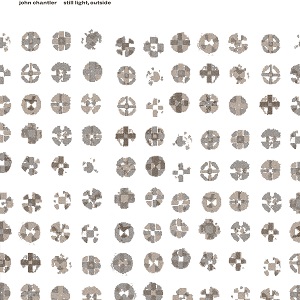John Chantler, "Still Light, Outside"
 St. John at Hackney, the parish on Lower Clapton Road in the London Borough of Hackney, was consecrated in 1798. Nineteen years earlier, surveyor Richard Jupp proposed expanding the capacity of the original structure, which was situated to the southwest, where the tower of St. Augustine still stands. The need for more seats, spurred by the church’s convenient location, was supposed to have guaranteed a larger space, but architect James Spiller convinced its trustees that fewer seats and a smaller space would better serve the church’s acoustics. The organ now inside St. John’s, a gorgeous three manual Mander, was installed much later, after May 18th, 1955, when a fire started in the church’s roof, ate through its galleries and pews, and finally consumed the original organ built by George Pike England. Stockholm’s Elektronmusikstudion EMS, where John Chantler assembled and recorded a portion of Still Light, Outside, was constructed nine years later, in 1964. The other portion of his album was recorded at St. John’s, on the three manual Mander. Chantler’s music is loud, physically powerful, and spacious, as evocative of material, location, and history as it is of composition. It is, in an obvious way, a combination of the new and old, but also a model for the passing of time and the endurance of sound.
St. John at Hackney, the parish on Lower Clapton Road in the London Borough of Hackney, was consecrated in 1798. Nineteen years earlier, surveyor Richard Jupp proposed expanding the capacity of the original structure, which was situated to the southwest, where the tower of St. Augustine still stands. The need for more seats, spurred by the church’s convenient location, was supposed to have guaranteed a larger space, but architect James Spiller convinced its trustees that fewer seats and a smaller space would better serve the church’s acoustics. The organ now inside St. John’s, a gorgeous three manual Mander, was installed much later, after May 18th, 1955, when a fire started in the church’s roof, ate through its galleries and pews, and finally consumed the original organ built by George Pike England. Stockholm’s Elektronmusikstudion EMS, where John Chantler assembled and recorded a portion of Still Light, Outside, was constructed nine years later, in 1964. The other portion of his album was recorded at St. John’s, on the three manual Mander. Chantler’s music is loud, physically powerful, and spacious, as evocative of material, location, and history as it is of composition. It is, in an obvious way, a combination of the new and old, but also a model for the passing of time and the endurance of sound.
The album’s title track and opening song begins lightly but quickly amasses weight as it transforms from a sparse array of isolated notes and synthesized noise into a mountain of stratified chords, distorted drones, and floor-shaking bass. Over the course of nine minutes, Chantler separates his original organ recordings into different registers, then distinguishes them further by degree of post-processing.
Much of "Still Light, Outside" sounds like it originated inside St. John’s pipe organ. Not just the ringing samples with their metallic overtones, but the long, endlessly variable swaths of geologic rumble and over-driven melody too. Unlike the trilogy that occupies the rest of the album, this work seems to take all of its sustenance and reason from the organ itself: the heft of its construction, the details of its mechanisms, and its presence inside a place of worship. Coincidentally, the light of the title shows up in the way that Chantler breaks the organ’s irradiated voice against the darker shades of its manipulated self. The image of light glowing through stained glass, and a feeling of heat, is difficult to shake, even as "The Long Shadow of Decline" sinks the record into a play of concealed movements and blaring discordances.
"Decline - Part I" quickly introduces electroacoustic miscellany, the sources of which are unidentifiable, except that they must have originated in a machine. They are loosely rhythmic and surrounded by low hums and high, hissing tones, high enough that they sound more like whistles than organ pipes. The combination of echoing noises and opposite pitches creates a feeling of spaciousness—musically, architecturally, and chronologically. The harmonious chords that occupy the central part of the piece are somewhat muffled, like Chantler recorded them from outside the church. They also exhibit a resonance that contrasts sharply with the electronic flutter that accompanies them. The mood is more relaxed, contemplative, and the pace is slower. There are no sudden movements, no sharp increases in volume. The music stretches out in every direction and stops, it would seem, only because Chantler decided it had to stop.
Parts two and three tread back up the mountain, to the intensity of "Still Light, Outside." This time the modern instruments show off their own voice instead of bolstering the organ’s. Small armies of metallic pebbles march across the face of the organ’s sustained blasts, layers of reeds and squealing wires are stacked on top of each other like lead weights, and the music turns monolithic. The conclusion converts that weight into a force, which, for a time, seems as if it could tear the album to shreds. But the organ continues steadily on and the electronics, despite their jabbering and convulsing, return to a calm state. A bass heavy loop slowly restores order, and then the album fades away in exhausted agreement.
It’s easy to see some concord between the new and the old in this, between two different kinds of engineered brilliance, but there’s also a hint of illusion. The sound of both instruments coexist whatever their history, the one transformed by the other through the efforts of Chantler and the people responsible for building, installing, and preserving the organ. And even if the original at St. John’s was burnt to ruin in 1955, some semblance of it persists in 2015, brought out of the past like a time traveler, something that moves faster than light.
samples:
 



